
Eating disorder sufferers on Twitter
People suffering from an eating disorder are usually seen as individuals, with individual problems. In this article, I will consider them as a social group. They are known to communicate with each other on pro-ana sites but are also found on social media. Pro-ana sites are marked as dangerous, but does the same apply to the eating disorder community on social media?
Who are these people in the eating disorder community
Any of a range of psychological disorders characterized by abnormal or disturbed eating habits can be considered an eating disorder. Most people are familiar with anorexia nervosa (characterized by a pathological fear of weight gain leading to faulty eating patterns, malnutrition, and usually excessive weight loss) or bulimia nervosa (characterized by compulsive overeating usually followed by self-induced vomiting or laxative or diuretic abuse).
A more unfamiliar eating disorder can be binge eating (characterized by recurring episodes of the consumption of large quantities of food in a short period of time) or ‘eating disorder not otherwise specified’. All these people suffering from such eating disorders form a community. Examples of this can be seen online on platforms such as Twitter.
What is it like to be a member of this community? Can it be triggering or even dangerous?
Digital ethnography and used data
People with an eating disorder (ED) mainly interact with others who have an ED online. They do this because online communication holds a sense of anonymity. Therefore in order to study this social group, digital ethnography is a useful approach. “Digital ethnography is research on online practices and communication, and on offline practices shaped by digitalization” (Varis, 2016).
People with an ED can be influenced and thus shaped by digitalization: they may gather tips or inspire others to worsen their behaviors.
My field of research will focus on the eating disorder community on Twitter. Data was collected through participant observation of 200 Twitter accounts for three weeks. The users selected all had public profiles and were identifiable as people who explicitly stated that they have an eating disorder.
Many users use this platform as a sort of diary, to vent about their struggles. Even though these profiles are publicly tweeting, I will always anonymize the data. Many users see it as a sort of diary, and thus do not necessarily see their tweets as public. The screenshots of tweets will have no username or date in it. It is also important to remember “that we indeed only see what is on the screen. […] what is observable on the screen can be misleading, or at least only provide a partial image.” (Varis, 2016).
Characteristics of an 'eating disorder Twitter-account'
There are some characteristics by which you can identify an eating disorder related account. They talk in a certain language so that ‘outsiders’ will not recognize right away what they mean. If you are part of this community you have to understand and talk like that too, “one has to have, display and enact ‘enough’ of the emblematic features in order to be ratified as an authentic member of an identity category” (Maly & Varis, 2015).
This language is used by both pro-ana communities and anti-ana communities. Pro-ana is an abbreviation for pro-anorexia. The difference between pro-ana and anti-ana is that pro-ana is seen as encouraging eating disorders, literally promoting anorexia. They use mean language or potentially triggering comments to encourage others to feel bad about themselves, which can lead to someone starving her- or himself. Anti-ana means the opposite, so not deliberately trying to encourage others in unhealthy behaviors. The line between pro-ana and not pro-ana (anti-ana) can be blurry at times.
A common thing to talk about is your ‘gw’, or in other words your goal weight. Similarly, you have ‘cw’ (current weight), ‘hw’ (highest weight), ‘lw’ (lowest weight) and ‘ugw’ (ultimate goal weight). These abbreviations are a common thing to put in your biography, together with your height or Body Mass Index (BMI). Another abbreviation is ‘b/p’, which means binging (eating a lot of food) and purging (self-induced vomiting). Purging often can be really dangerous and is therefore not to be seen as something to encourage but discourage.
As said before, Twitter is seen as a diary, to vent about your struggles and feelings. Trackers for your weight, periods of fasting or your calorie intake are a recurring thing. Using apps for tracking these things is routine for most. Most share their ‘progress’ every day.
Diet plans are also shared. These are not self-made but come from pro-ana sites. Most diet plans are seen as a challenge and the calorie intake that these diet plans encourage is very low and very dangerous. These diet plans can influence and inspire someone to lower their calorie intake even further.
The same is true for sharing ‘thinspo’ (pictures of skinny people used as inspiration and motivation to lose weight). They are not meant to purposely influence others, but seeing them pop-up can be triggering, just like seeing someone's weight that’s lower than yours. Most people on these ‘thinspo’ pictures don’t even know they are used for the purpose of motivating others to lose weight. Common ‘thinspo’ people are models or K-Pop idols.
Outsiders in society, together on Twitter
“People who engage in activities regarded as deviant typically have the problem that their view of what they do is not shared by other members of the society.” (Becker, 1963). People suffering from an eating disorder (ED) have disordered thoughts and their eating habits are thus labeled as 'sick' according to medical criteria.
On a societal level, people with ED are or considered sick, or as 'abnormal' or 'deviant'. Their behavior does not align with the norm. Mainstream society can’t particularly understand or relate to these thoughts that people with an ED have. Isolation from other people can happen because of this. They form their own community where they can be understood, and so the culture grows (Becker, 1963). In this case, people that don’t understand them — like doctors or parents - become the outsiders.
To fill the void caused by isolation, they interact with others who have an eating disorder. They mainly do this online, where they can have a sense of anonymity. Pro-ana sites are an example of where they can interact. These internet sites actively promote anorexia. They sell having an eating disorder as a lifestyle rather than an illness that requires treatment (Johnson & Derner, 2015). They share tips on how to lose more weight and encourage disordered behavior.
Twitter is also a platform that is used among people with an ED. This community is less known among the mainstream. The difference between these Twitter accounts and Pro-ana sites is that the ED-community on Twitter is anti-ana: they don’t want to inspire others to indulge in such behavior and they make sure that they make it explicit themselves that their behavior is indeed an eating disorder and not a lifestyle. They use this platform to vent about their feelings, more or less like a private diary or talk to others who feel the same way they do.
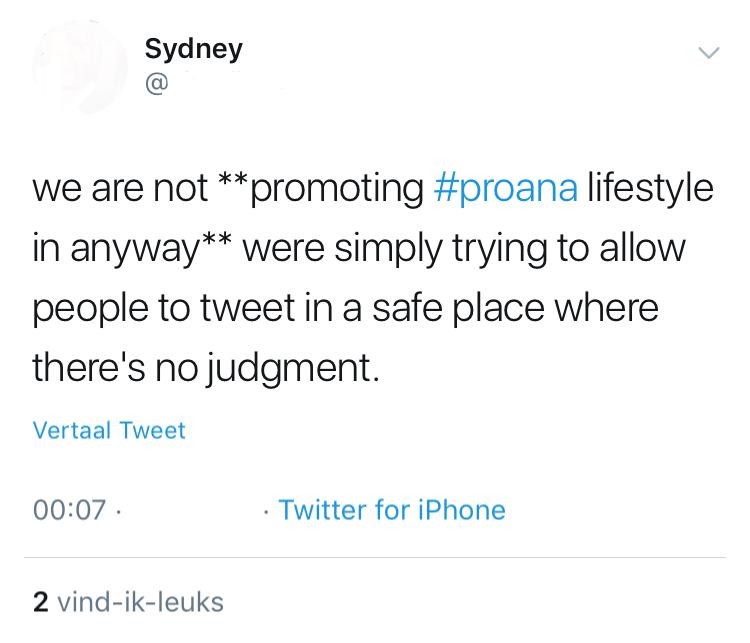
Someone from the ED community claiming that the Twitter community is not pro-ana
They don’t deliberately want to inspire others to indulge in such behavior and they make explicit that their own behavior is indeed an eating disorder and not a lifestyle
Having an eating disorder is not a voluntary act. These people are struggling, and seek support or validation from others that are more or less experiencing the same thing. This builds a kind of culture, that can be seen as dangerous on one hand, but comforting to others on the other hand. As a result of this online interaction, a social group and a culture is born. As Becker states,
“Where people who engage in deviant activities have the opportunity to interact with one another they are likely to develop a culture built around the problems rising out of the differences between their definition of what they do and the definition held by other members of the society. They develop perspectives on themselves and their deviant activities and on their relations with other members of the society. (…) Since these cultures operate within, and in distinction to, the culture of the larger society, they are often called subcultures.” (Becker, 1963)
Not only do members of this ED-community interact by replying to each other’s tweets, but group chats are also made. Within a group chat they seek a closer connection, sharing their more personal or private thoughts that they don’t share on their (public) Twitter. For example, there are group chats against binging. Here they discourage binging because it leads to feeling guilty and disgusted about yourself. There are also group chats that are pro-recovery, where they help others to recover and encourage more healthy behavior, such as upping your daily calorie intake.
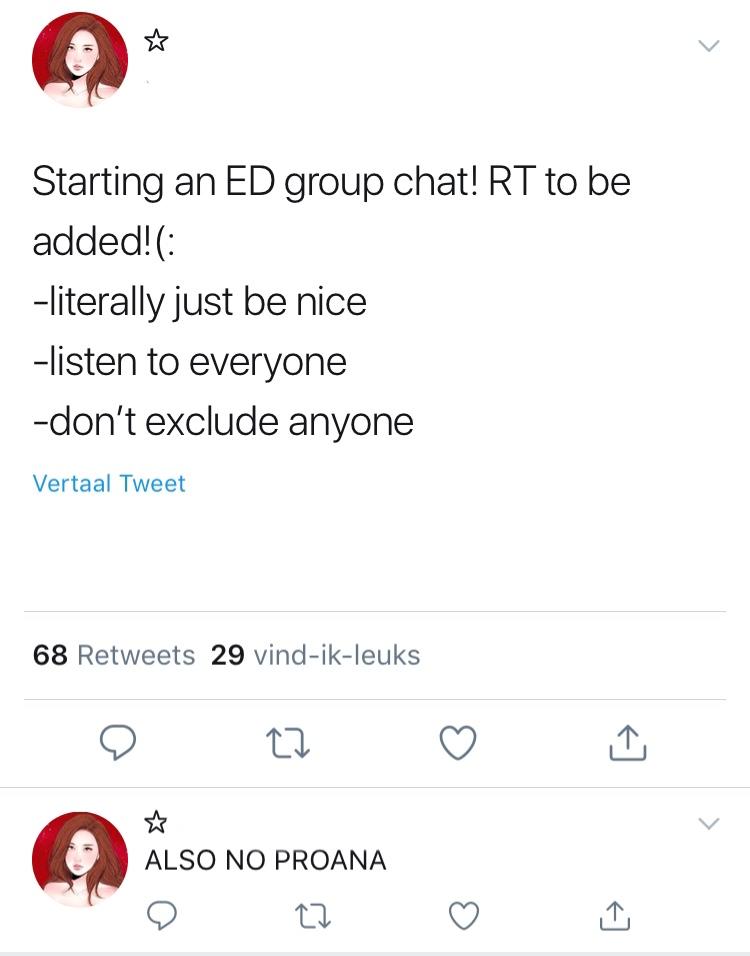
Someone from the ED community asking if people want to join a group chat
Norms and rules within the eating disorder community
An obvious norm to be part of this group is having an eating disorder. It doesn’t have to be diagnosed and what sort of disordered behavior related to eating can differ. They, themselves, define themselves as a group and refer it to 'ed twt', an abbreviation for 'eating disorder twitter'.
An eating disorder doesn’t discriminate and thus everyone can become a member if you suffer from an eating disorder. This creates diversity in an already diverse group (Vertovec, 2006). It doesn’t matter what you weigh, if you have disordered thoughts and behavior in relation to food you will be seen as a member. This is in contrast with doctors or people around them: they won’t recognize their eating disorder if they have a ‘healthy’ weight or are still overweight. This recognition from others makes them feel valid.
An eating disorder doesn’t discriminate and thus everyone can become a member if you suffer from an eating disorder.
People just looking for weight-loss tips are not accepted in this community. They see an eating disorder as a ‘quick fix’ to lose weight and not a real illness. This makes members of the eating disorder community angry because it leads to romanticizing an illness that actually can be severe and needs to be recognized.
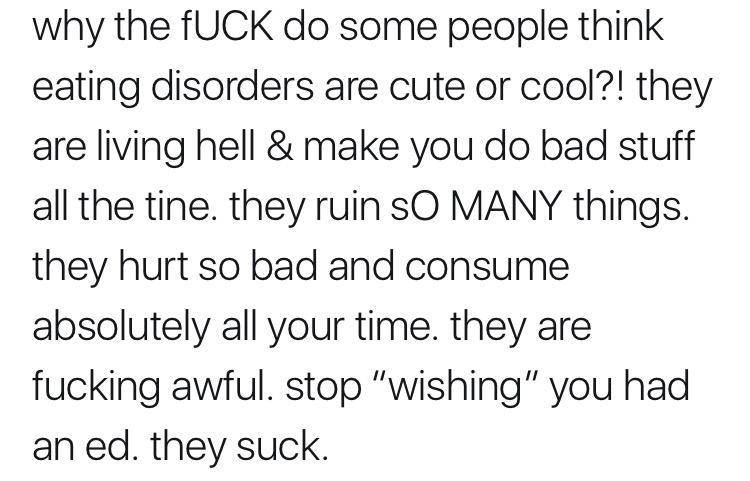
Twitter quote from the ED community against romanticizing eating disorders
Bullying is not accepted in mainstream society and within the ED community on Twitter, it is also not tolerated. People with an ED basically bully themselves, but they don’t allow any bullying towards others.
Being pro-ana is a thing that can make you an outsider to the group or not. “Social groups create deviance by making rules” (Becker, 1963). It’s not accepted in this group to be pro-ana. You must not encourage disordered behavior. So if anyone puts up a poll asking if he or she should fast or just eat a little you have to vote to eat a little. Or if anyone shares a picture of themselves you must not say that they are still too fat or that they should be proud of being so underweight, no, you tell them to be safe.
Encouraging disordered behavior makes you deviant and not accepted in this community. Most accounts disclose that what they tweet are merely thoughts which should not be followed. It’s also a common thing to put ‘not pro’ or ‘no pro-ana’ in your bio on twitter. With this you can indicate that you will not behave ‘pro’: you will not knowingly encourage others in their illness or romanticize it.
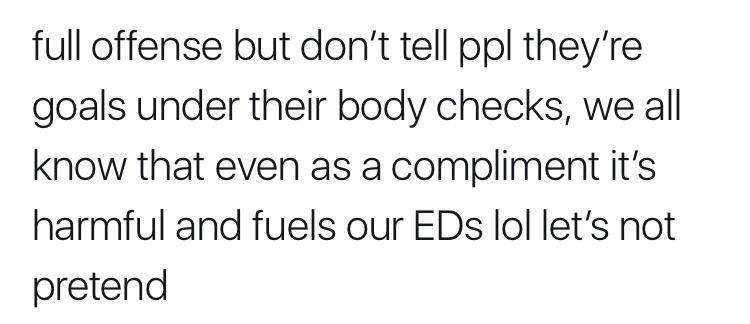
Twitter quote from the ED community against encouraging others in disordered behavior
Weight loss products
This group are also consumers. The importance of the new structure of the economy in relation to this social group in this case is important. Our society has become more about consumption, i.e., “neoliberalism constituted by precisely such globalized mass-produced niche economies” (Maly & Varis, 2015). This social group “is connected to a certain ethos of consumption, and from this perspective is perfectly aligned with the neoliberal structure of the world economy where, in our post-Fordist era, mass production for all has been replaced by niched mass production catering for the (identity) needs of specific, smaller groups” (Maly & Varis, 2015).
This may surprise you because eating disorders are mainly about restricting food. New low-calorie products are frequently entering the market. Diet soda’s, zero calorie noodles and low-calorie ice cream are very popular under the ED community. These products are not specifically marketed towards people struggling with eating disorders, but for people struggling to lose weight in general. A part of the disorder is to abuse these products.
Memes and trolling
Having an eating disorder is quite serious, but people in the ED community also make memes about their disordered thoughts and behaviors to put it in perspective. This way they can relate to others in a not so serious way.
Meme on Twitter about eating disorders
Unfortunately, this group is also a target of trolling. Disruptive behavior by outsiders with the intent to hurt someone or get a reaction out of them is not rare. “Succesful trolling is often dependent on the target’s lack of anonymity, or at least there willingness to disclose real-life attachments, interest, and vulnerabilities” (Phillips, 2016). Putting your thoughts out on the internet is a vulnerability and when you share pictures of yourself you become even more of a target.
An example of a troll is this woman who says she is a nurse, which makes you think she would understand that eating disorders are a mental illness, but instead she calls someone a ‘walking skeleton’, saying they are a ‘bag of bones’ and direct messages someone that ‘all these bulimics just want attention’.
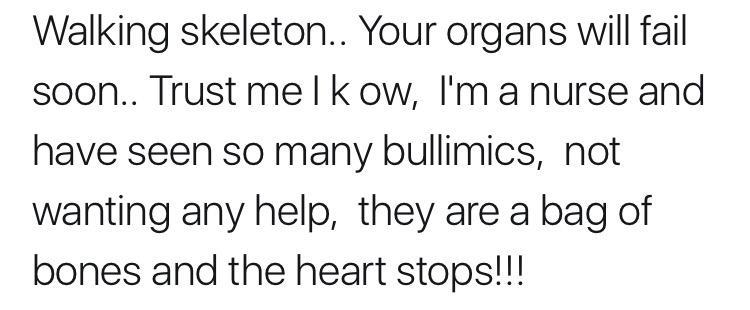
A tweet from a troll to someone from the ED community
Dangerous, but comforting
The members of the community mark themselves as not being pro-ana but sharing things as ‘thinspo’ can, on the other hand, be seen as pro-ana, because you are promoting the image of being thin. While having a community can be comforting because you can relate to other people going through the same thing as you, it also can be triggering and dangerous if it influences someone into restricting their food or indulging in other disordered behaviors Some even keep coming back to the community because they know it triggers them and pushes them to be more strict, others help each other recover to a healthier life. At the same time, no pro-ana or anti-ana comments can help someone struggling with an eating disorder or raise awareness.
References
Becker, H. (1963). Outsiders. Free Press of Glencoe. The University of Michigan.
Johnson, H.A., & Derner (2015). I Will Not Eat! A Review of the Online Pro-Ana Movement.
Maly, I & Varis, P. (2015) The 21st century hipster: on micro-populations in times of super-diversity
Definitions of anorexia nervosa, bulimia nervosa and binge-eating disorder in Dictionary by Merriam Webster
Phillips w. (2016). The origins and evolution of subcultural trolling
Varis, P. (2016) Digital ethnography.
Vertovec, S. (2006). The emergence of super-diversity in Britain. Centre of Migration, Policy and Society, Paper 25.